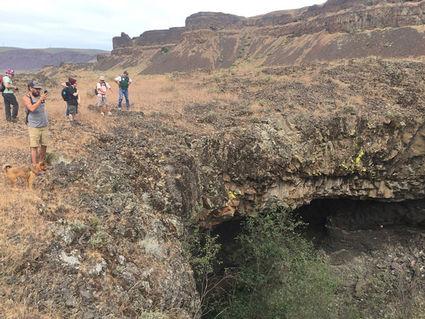Geologist Bjornstad gives guided hike
Last updated 6/28/2017 at 10:59am

Geologist Bruce Bjornstad, second from right, leads a group of hikers on a tour of the unusual features of the coulee, including giant potholes like this one. - Jacob Wagner photo
Geologist Bruce Bjornstad came to Dry Falls-Sun Lakes State Park June 17 to give a guided tour of the Caribou Trail to a dog and about 10 human hikers who were local, from the Seattle area, and from as far away as New England.
The approximately 90-minute guided hike started with Bjornstad showing maps of the area depicting what things were like during the Missoula Floods. He showed how a large ice dam used to be where the Grand Coulee Dam is now, and how that had diverted the Columbia River through the Grand Coulee, past Steamboat Rock, and on down the upper and lower Grand Coulee. When the ice dam melted, the Columbia took on its current course.
Bjornstad explained the time-scale of the coulees being carved, explaining what a unique feature they are on the planet Earth, the closest thing similar being the landscapes of the planet Mars.
Hiking to huge potholes resembling craters above Deep Lake, Bjornstad explained that they were formed by whirlpools or eddies in the waters that had flooded the region, and simply dug the rocks out of the ground and sent them flying with the sheer force of the current.
"These are some of the best potholes in the world," Bjornstad said. "There's dozens of them up there. A lot of times you won't see them until you're right up next to them within a few feet, when all of the sudden the ground will disappear. They can be hundreds of feet deep and hundreds of feet wide."
Throughout the hike, Bjornstad answered questions and explained geological features of the region.
A video series Bjornstad produces called Floodscapes is available to view on YouTube. The videos show stunning aerial footage shot with a drone of landscapes shaped by the Missoula Floods, including the Deep Lake Potholes.

Reader Comments(0)